brake pads AUDI S3 SEDAN 2015 Owners Manual
[x] Cancel search | Manufacturer: AUDI, Model Year: 2015, Model line: S3 SEDAN, Model: AUDI S3 SEDAN 2015Pages: 282, PDF Size: 71.14 MB
Page 20 of 282
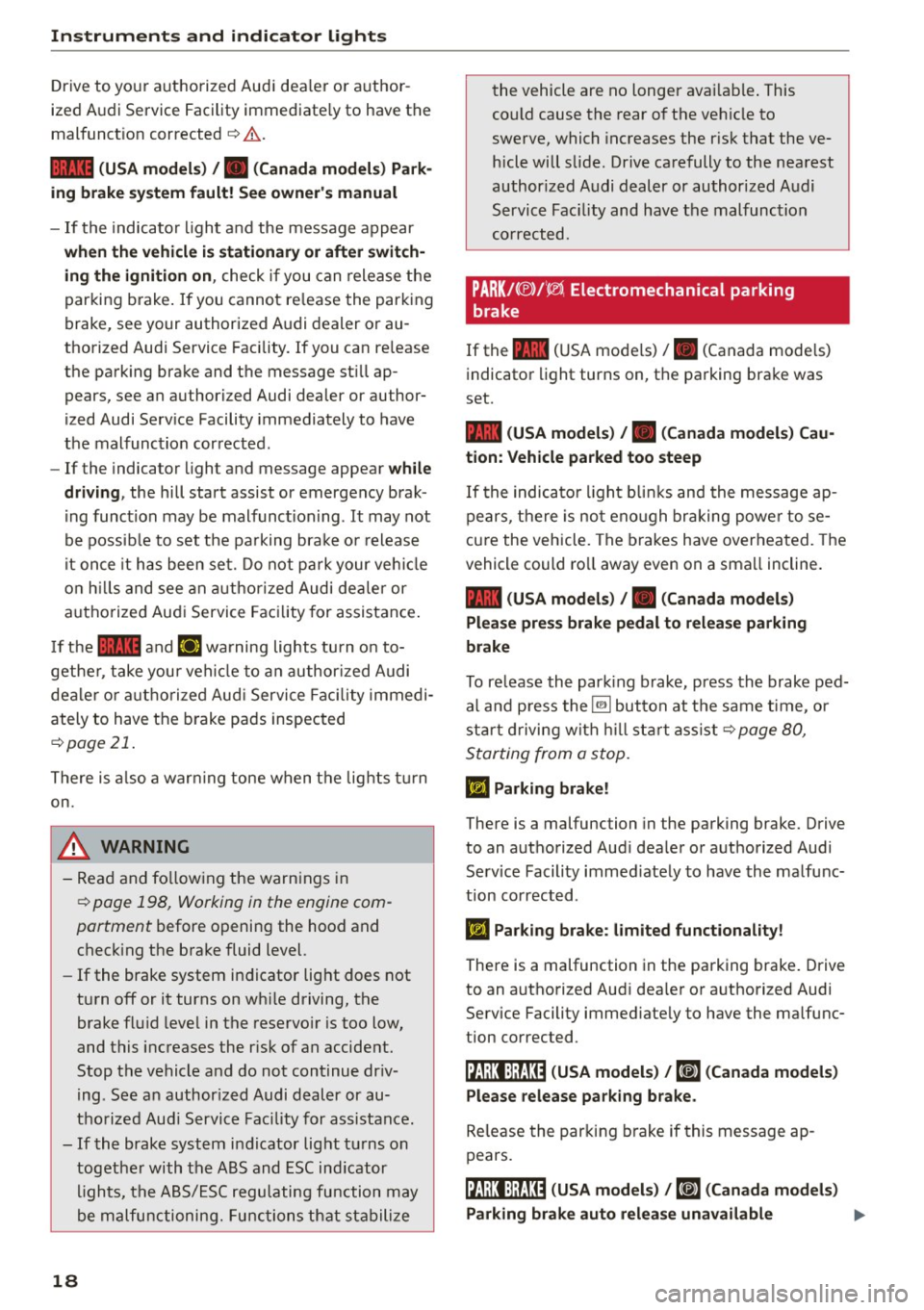
Instruments and indicator lights
Drive to your authorized Audi dea le r or a uthor
ized Audi Service Facility immediate ly to have the
malfunct ion corrected
¢ .&. .
1111 (USA m od els) /. (C an ada mod els) Park
ing brake sy stem f ault! See owner' s manual
- If the indicato r light and the message appear
wh en th e vehi cle is stationar y or aft er swit ch
ing the ignit ion on ,
check if you can release the
parking b rake . If you cannot re lease the parking
brake, see your authorized A udi dealer or au
thorized Audi Service Facility. If you can re lease
the parking brake and the message st ill ap
pears, see an authori zed Audi dealer or author
ized Audi Serv ice Facility immediately to have
the malfunct ion corrected .
- If the indica tor light and message appear
whil e
driving ,
the hill start assist or emergency brak
i ng function may be malfunct ion ing . It may not
be possib le to set the pa rking brake o r release
i t once it has been set. Do not pa rk your ve hicle
o n hill s and see an authorized Audi dea ler or
authorized Audi Service Fac ility for assistance .
If the
1111 and El warning lights turn on to
gethe r, take you r veh icle to a n author ized Audi
dealer o r autho rized Aud i Service Faci lity immedi
ately to have the b rake pads inspected
¢ page 21 .
There is a lso a war ning tone when the lights t urn
on .
_& WARNING
- Read and fo llow ing the warn ings in
¢ page 198, Working in the engine com
partment
before opening the hood and
check ing the brake fluid level.
- If the brake system indicator light does not
turn off or it turns on wh ile driving, the
brake flu id leve l in the reservo ir is too low,
and this increases the r isk of an accident.
Stop the vehicle and do not continue dr iv
ing . See an author ized Audi dealer or au
tho rized Aud i Service Fac ility for assistance.
- If the brake system indicator light tu rns on
together with the ABS and ESC ind icator
lights, the ABS/ ESC regu lating fu nction may
be malfunctioning. Functions th at stabilize
18
the vehicle are no longer ava ilable . This
could cause the rear of the vehicle to
swerve, which increases the r isk that the ve
hicle will slide. Drive carefully to the nearest
author ized Audi dealer or authorized Audi
Service Fac ility and have the malfunction
corrected.
PARK/(®)/ ~ Electromechanical parking
brake
If the -(U SA mode ls) /. (Canada mode ls)
indicato r light turns on, t he parking brake was
set.
- (USA model s) / . (Canad a model s) Cau
tion: Vehicle parked too steep
If the indicato r ligh t blink s and the message ap
pe ars, there is no t eno ugh braking powe r to se
cu re the vehicle. The brakes have overheated. The
vehicle could ro ll away even on a sma ll incline.
- (USA mod els ) /. (Canada model s)
Plea se pr ess brak e pedal t o rel ease parking
br ake
To re lease the park ing brake, press the brake ped
al and p ress the~ button at the same time, o r
star t driving with hill start assist
¢page 80,
Starting from a stop.
Ill Parking brak e!
There is a malfunc tion in the parking brake. Drive
to an authorized Aud i dea ler or authorized Audi
Service Facility immed iately to have the malfunc
tion co rrected .
Ill Parking brake: limited functionality !
There is a malfunction in the parking brake. Drive
to an authorized Audi dea ler or a uthori zed Audi
Service Facility immed iate ly to have the ma lfunc
tion correc ted.
!~;1 ;1J: );J;13~ ( USA models ) / ¢@'A
Release the par king brake if this message ap
pears.
lt1 ;1J :);tJ :H ( USA m odels ) / iiJ (Canada models)
Parking brake aut o release unavailable
...
Page 23 of 282
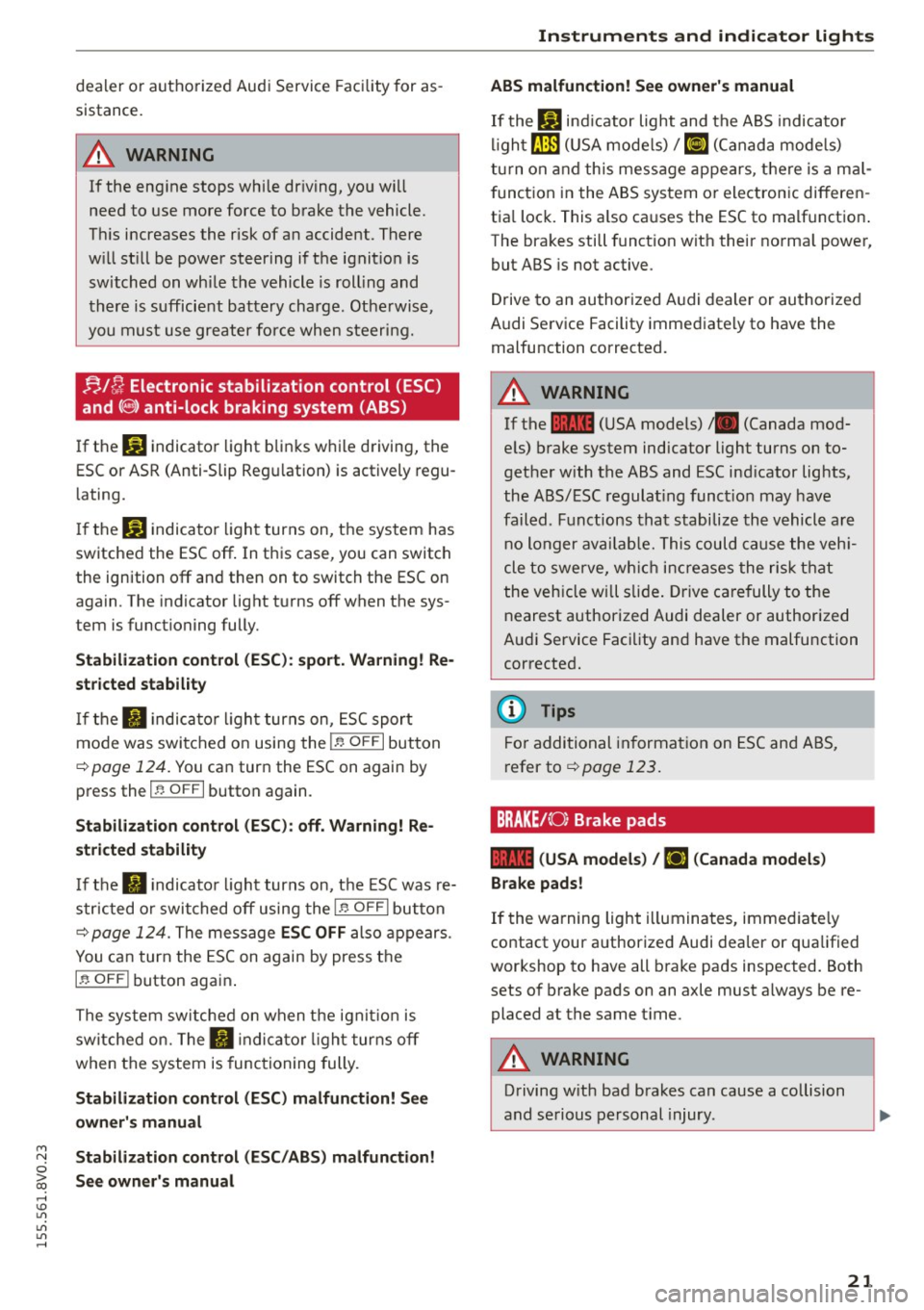
dealer or authorized Audi Service Facility for as
sistance.
A WARNING
If the engine stops while driving, you will
need to use more force to brake the vehicle.
This increases the risk of an accident. There
will still be power steering if the ignition is
switched on while the vehicle is rolling and
there is sufficient battery charge. Otherwise,
you must use greater force when steering.
!;.!~ Electronic stabilization control (ESC)
and
(8) anti-lock braking system (ABS)
If the DJ indicator light blinks while driving, the
ESC or ASR (Anti-Slip Regulation) is actively regu
lating.
If the
DJ indicator light turns on, the system has
switched the ESC off. In this case , you can switch
the ignition off and then on to switch the ESC on
again. The indicator light turns off when the sys
tem is functioning fully.
Stabilization control (ESC): sport. Warning! Re
stricted stability
If the II indicator light turns on, ESC sport
mode was switched on using the
i .i, O FF I button
¢ page 124. You can turn the ESC on again by
press the
i .i, OFFI button again .
Stabilization control (ESC): off. Warning! Re
stricted stability
If the II indicator light turns on, the ESC was re
stricted or switched off using the
I.$ O FF I button
r::!:> page 124. The message ESC OFF also appears.
You can turn the ESC on again by press the
i.i, OF F! button again.
The system switched on when the ignition is
switched on. The
II indicator light turns off
when the system is functioning fully.
Stabilization control (ESC) malfunction! See
owner's manual
M N Stabilization control (ESC/ABS) malfunction! 0
iii See owner's manual ,...., \!) 1.1"1
1.1"1
1.1"1
,....,
Instruments and indicator lights
ABS malfunction! See owner's manual
If the Bl indicator light and the ABS indicator
light[!] (USA models) /
¢0) (Canada models)
turn on and this message appears, there is a mal
function in the ABS system or electronic differen
tial lock. This also causes the ESC to malfunction.
The brakes still function with their normal power,
but ABS is not active.
Drive to an authorized Audi dealer or authorized
Audi Service Facility immediately to have the
malfunction corrected.
A WARNING
If the 1111 (USA models) /. (Canada mod
els) brake system indicator light turns on to
gether with the ABS and ESC indicator lights,
the ABS/ESC regulating function may have
failed . Functions that stabilize the vehicle are
no longer available. This could cause the vehi
cle to swerve, which increases the risk that
the vehicle will slide. Drive carefully to the
nearest authorized Audi dealer or authorized
Audi Service Facility and have the malfunction
corrected.
(D Tips
For additional information on ESC and ABS,
refer tor::!:> page
123.
BRAKEt< O: Brake pads
1111 (USA models) / [IJ (Canada models)
Brake pads!
If the warning light illuminates, immediately
contact your authorized Audi dealer or qualified
workshop to have all brake pads inspected. Both
sets of brake pads on an axle must always be re
placed at the same time.
A WARNING
-Driving with bad brakes can cause a collision
and serious personal injury .
21
Page 24 of 282
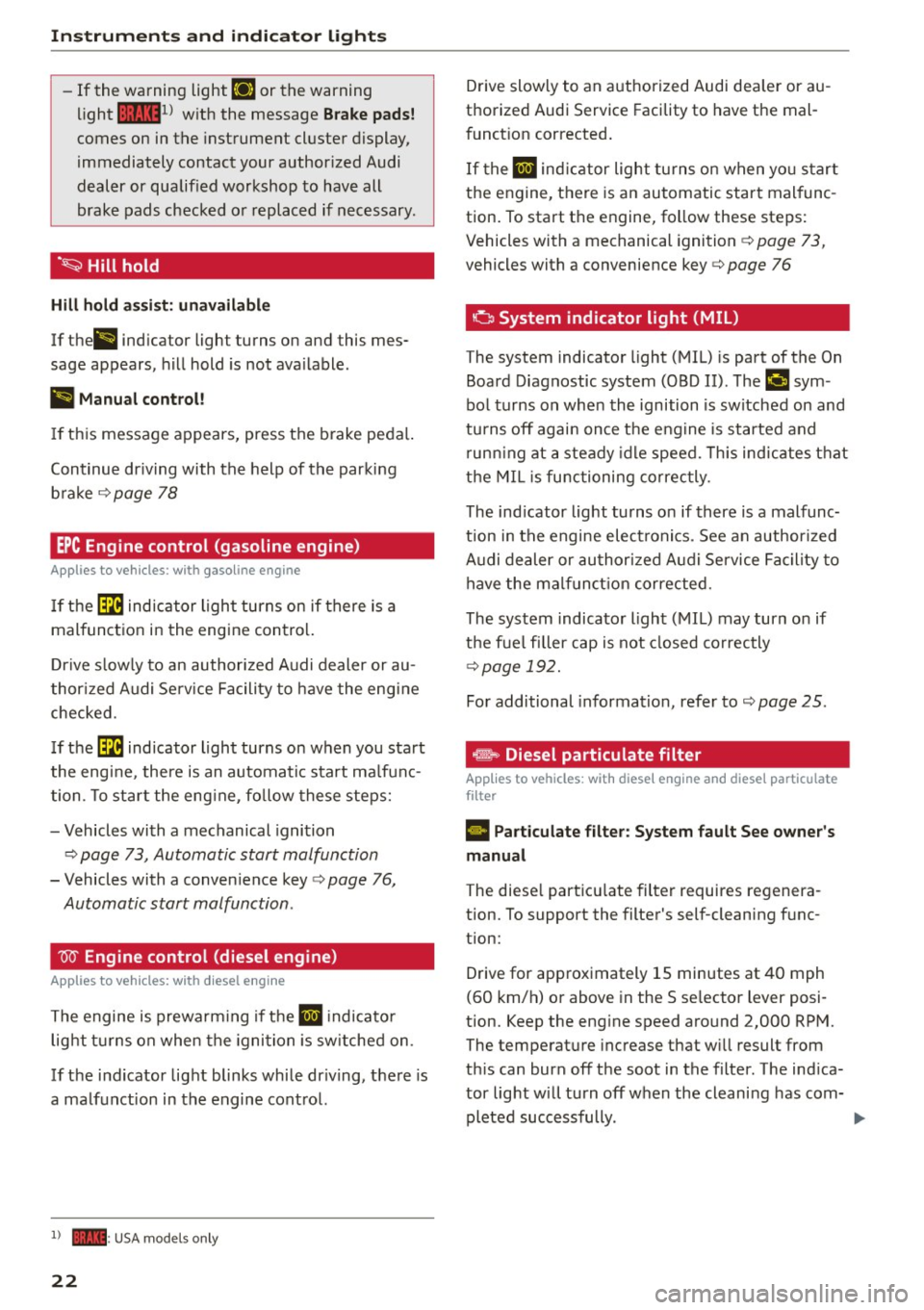
Instruments and indicator lights
-If the warnin g light EiJ or the warning
light
11111 ) w ith the message Brake p ads!
comes on in the instrument cluster display,
immediately contact your author ized Audi
dealer or qualified workshop to have all
brake pads checked o r replaced if necessary.
·~ Hill hold
Hill hold assi st: unavailable
If the ll ind icator light turns on and this mes
sage appears, hill hold is not ava ilable.
II Manual control!
If thi s message appears, press the b rake peda l.
Continue dr iv ing with the help of the parking
b ra ke
¢ page 78
EPC Engine control (gasoline engine)
A pp lies to veh icles: w ith gaso line engine
If th e ~ indica tor ligh t turns on if there is a
malfunct ion in the engine contro l.
D rive s low ly to an author ized A udi dealer or au
thor ized Audi Se rv ice Facility to have the eng ine
checked.
I f the ~ indicator light turns on when you sta rt
the eng ine, the re is an automatic start ma lf u n c
tion. To sta rt the eng ine, fo llow these steps:
- Vehicles with a mechanical igni tion
c:> page 73, Automatic start malfunction
- Vehicles with a conven ience key c:> page 76,
Automatic start malfunction .
W Engine control (diesel engine)
A pp lies to veh icles: w ith d iesel e ngi ne
T he engine is prewa rming if t he II indicato r
light t urns on when the igni tion is sw itched on .
If the indicator lig ht blinks while dr iv ing , th e re is
a ma lfunct ion in the engine cont ro l.
l) - : USA mode ls onl y
22
Drive slowly to an a uthorized Audi dea ler or au
thorized Audi Service Facility to have the mal
funct ion corrected .
I f the
II ind ic a tor light tu rns on w hen yo u start
t h e engine, t here is a n automatic start mal func
tion . To start the engine, follow these ste ps:
Vehicles with a mechanical ignition ¢
page 73,
vehicles with a convenience key c:> page 76
o System indicator light (MIL )
The system indicator light (MIL) is part of the On
Board Diagnostic system (OBD II). ThP
¢..ifi sym
bo l turns on whe n the ignition is switched on and
tu rns off agai n once t he eng ine is started and
r un ning at a steady id le speed. This ind ic a te s th at
t h e MIL i s func tioning correc tly.
The ind icator light turns on if there is a malfunc
t ion in t he engine electronics. See an author ized
A udi de aler or au thori zed A udi Service Faci lity to
h ave the mal funct io n corrected.
The system indicato r light (MIL) may turn o n if
the f ue l filler cap is not closed co rrectly
¢page 192.
For additional information, refer to c:> page 25.
... Diesel particulate filter
Applies to vehicles : wit h diese l eng ine a nd diese l particulate
filter
• Part iculate filter: System fault See owner's
manual
The diese l part icu late filter requires regenera
tion. To support the filter's self-cleaning f unc
tion:
D rive for app roximately 15 minutes at 40 mph
(60 km/h) o r above in the S se lector lever posi
tion. Keep the eng ine speed around 2,000 RP M.
The temperat ure increase that w ill result from
th is can burn off the soot in the filter. The ind ica
tor light w ill turn off when the cleani ng has com-
pleted successfully. .,..
Page 72 of 282
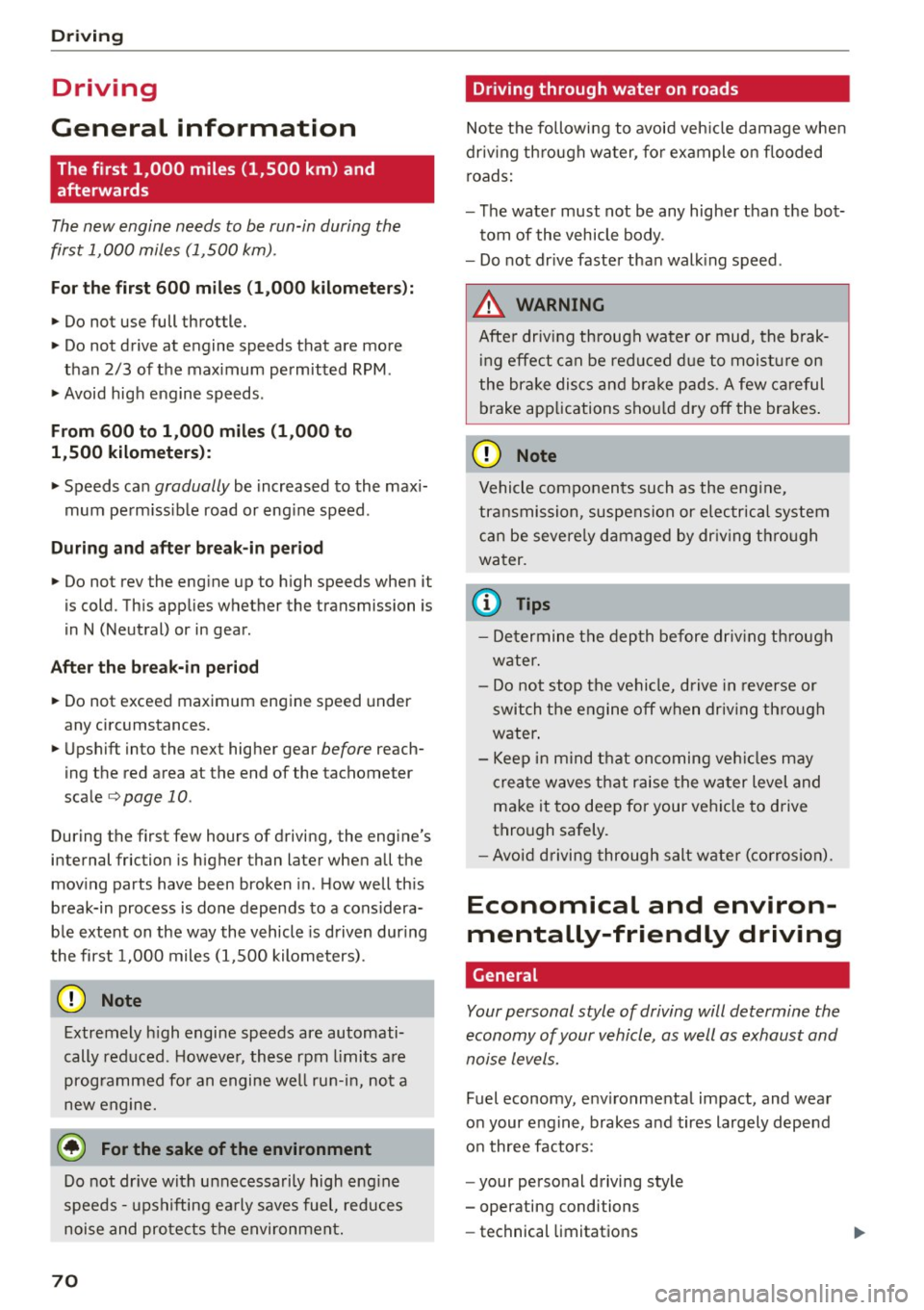
Driving
Driving
General information
The first 1,000 miles (1,500 km) and
afterwards
The new engine needs to be run-in during the
first 1,000 miles (1,500 km) .
For the first 600 miles (1 ,000 k ilometers ):
.. Do not use full throttle.
.. Do not drive at engine speeds that are more
than 2/3 of the maximum permitted RPM .
.. Avoid high engine speeds .
From 600 to 1,000 miles (1,000 to
1,500 kilometers):
.. Speeds ca n gradually be increased to the maxi
mum perm issible road or eng ine speed .
During and after break-in period
.. Do not rev the engine up to high speeds when it
is cold. This applies whether the transmission is
in N (Neutral) or in gear .
After the break-in peri od
.. Do not exceed maximum engine speed under
any circumstances.
.. Upshift into the next higher gear
before reach
ing the red area at the end of the tachometer
scale
opage 10.
During the first few hours of driving, the engine's
internal friction is higher than later when all the
mov ing parts have been broken in. How well this
break-in process is done depends to a cons idera
b le extent on the way the vehicle is driven dur ing
the first 1,000 miles (1,500 kilometers).
0 Note
Extremely high engine speeds are automati
cally reduced. However, these rpm limits are
programmed for an engine well run-in, not a
new engine.
@ For the sake of the environment
Do not dr ive with unnecessarily high eng ine
speeds -upshifting early saves fuel, reduces
noise and protects the environment.
70
· Driving through water on roads
Note the following to avoid veh icle damage when
driving through water, for example on flooded
roads:
- The water must not be any higher than the bot
tom of the vehicle body .
- Do not dr ive faster than walk ing speed .
A WARNING
After driv ing through water or mud, the brak
ing effect can be reduced due to moisture on
the brake discs and bra ke pads. A few careful
brake applications sho uld dry off the brakes .
(D Note
Vehicle components such as the eng ine,
transmission, suspension or electrical system
can be severe ly damaged by driv ing through
water .
(D Tips
- Determine the depth before driving through
water.
- Do not stop the vehicle, drive in reverse or
switch the engine off when driv ing th rough
water .
- Keep in mind that oncoming veh icles may
create waves that raise the water level and
make it too deep for your vehicle to drive
through safely.
- Avoid driving through salt wate r (corrosion).
Economical and environ
mentally-friendly driving
General
Your personal style of driving will determine the
economy of your vehicle, as well as exhaust and
noise levels.
Fuel economy, env ironmental impact, and wear
on your engine, brakes and tires largely depend
on three factors :
- your personal driving style
- operating conditions
- technical limitations
Page 127 of 282
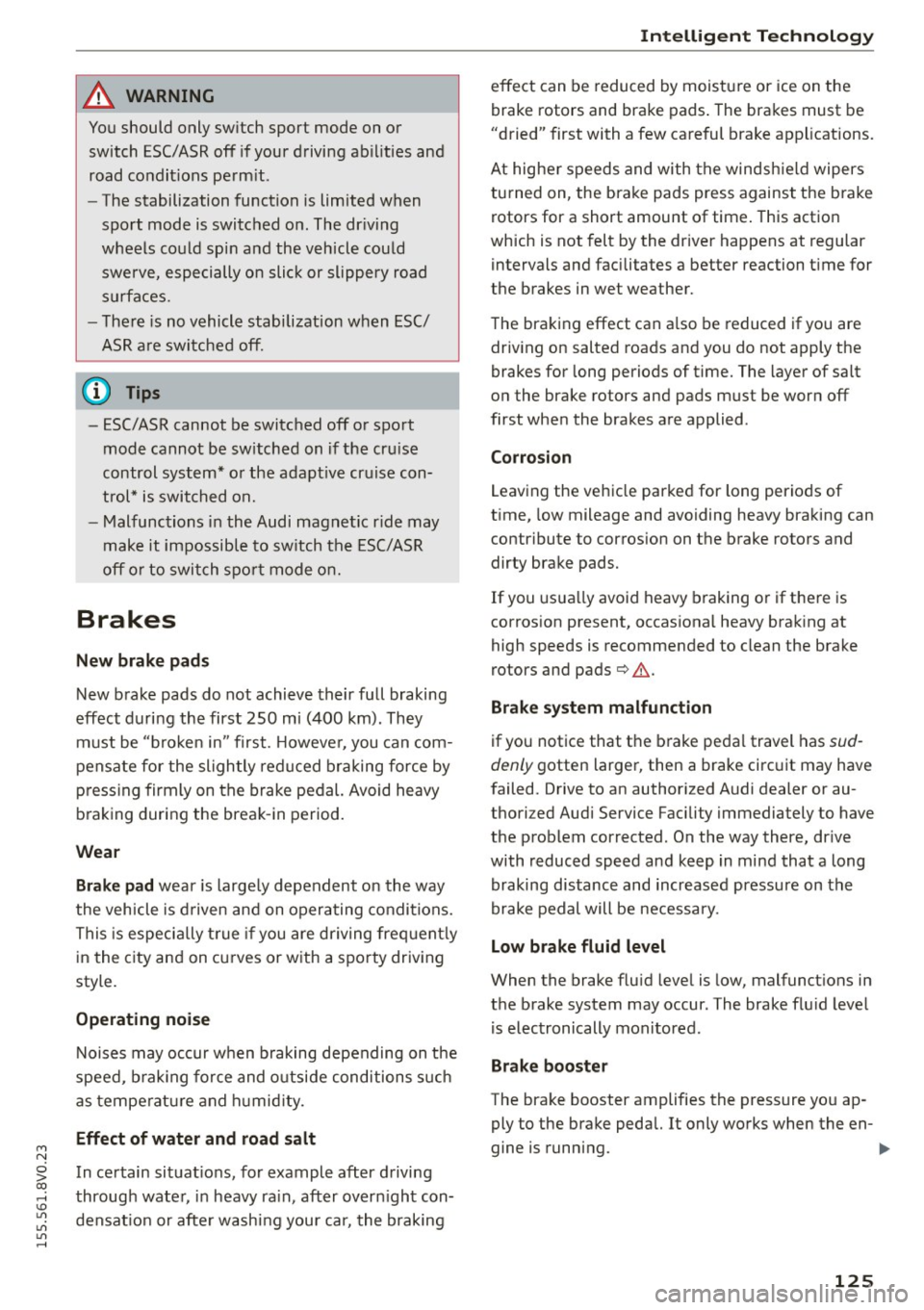
M N
0 > co ,...., \!) 1.1'1
1.1'1
1.1'1
,....,
A WARNING
You should only switch sport mode on or switch ESC/ASR off if your driving ab ilities and
road condit ions perm it.
- The stabilization function is limited when
sport mode is switched on. The dr iving
wheels could sp in and the veh icle could
swerve, especially on slick or slippery road
surfaces.
- There is no vehicle stabilization when ESC/
ASR are switched off.
(D Tips
- ESC/ASR cannot be switched off or sport
mode cannot be sw itched on if the cru ise
control system* or the adapt ive cruise con
trol* is switched on.
- Malfunctions in the Audi magnetic r ide may
make it impossible to sw itch the ESC/ASR
off or to switch spo rt mode o n.
Brakes
New brake pads
New brake pads do not achieve their full braking
effect during the first 250 mi (400 km). They
must be "broken in" f irst. Howeve r, you can com
pensate for the slightly reduced braking force by
press ing firmly on the b rake pedal. Avoid heavy
braking during the break -in period.
Wear
Brake pad wear is large ly dependent on the way
the veh icle is d riven and on operating co nditions.
This is especially t rue if you are driving frequent ly
in the city and on cu rves or with a sporty driving
style.
Operating noise
Noises may occur when braking depending on the
speed, b rak ing force and o utside conditions s uch
as tempe rat ure and h umid ity.
Effect of water and road s alt
In certain situat ions, for example after driving
throug h wate r, in heavy ra in, after overn ight con
densat ion or afte r wash ing you r car, the braking
In te llig ent T echnolog y
effect can be reduced by moisture or ice on the
brake rotors and brake pads . The brakes must be
"dried" first with a few careful brake applications.
At higher speeds and with the windsh ield wipers
turned on, the brake pads press against the b rake
rotors for a short amount of time . This action
wh ich is not felt by the driver happens at regular
intervals and facilitates a better reaction t ime for
the brakes in wet weather.
The braking effect can a lso be reduced if you are
driv ing on salted roads and you do not apply the
brakes for long periods of time. The layer of salt
on the brake rotors and pads must be worn off
first whe n the brakes a re applied .
Corro sio n
Leav ing the ve hicle parked for long periods of
t ime, low mileage and avoiding heavy braking can
contribute to corros ion on the brake rotors and
dirty brake pads.
If you usua lly avoid heavy b raking or if there is
corrosion present, occas ional heavy braking at
high speeds is recommended to clean the brake
rotors and pads¢,&.
Brake sy stem malfunct ion
if you notice that the b rake pedal travel has sud
denly gotten larger, then a brake circ uit may have
failed. Drive to an authorized Audi dealer or au
thori zed Audi Service Facility immediately to have
the problem cor rected. On the way there, dr ive
with reduced speed and keep in mind that a long
braking distance and increased pressu re on the
brake pedal will be necessa ry.
Low br ake fluid level
When the brake f lu id level is low, malfunct ions in
the brake system may occur. The brake flu id leve l
is electronically mon itored.
Brake boo ste r
The brake booster amplifies the pressure yo u ap
ply to the brake peda l.
It only works when the en-
gine is running.
IJ>
125
Page 128 of 282
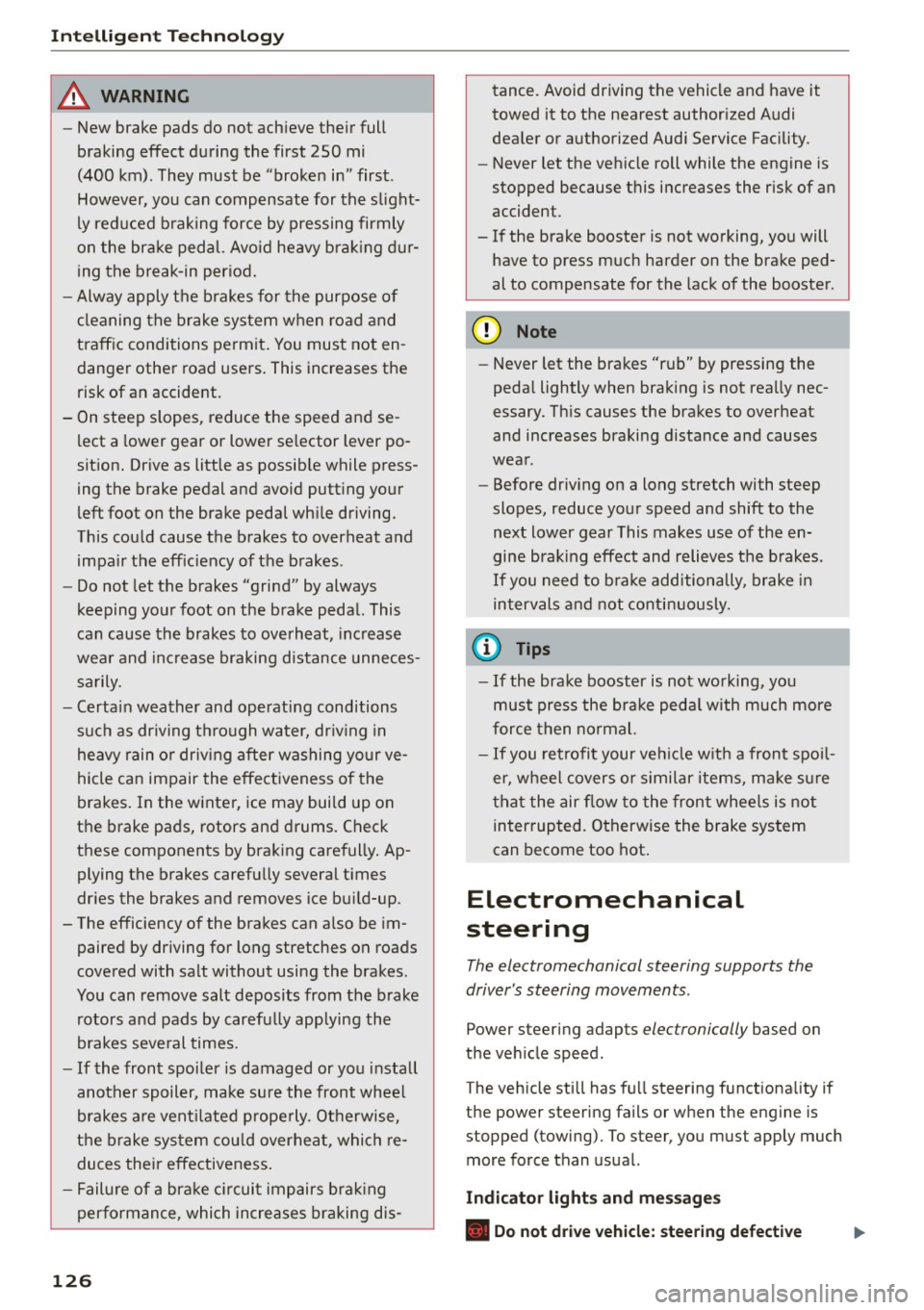
Intelligent Technology
& WARNING
-New brake pads do not achieve their full
braking effect during the first 250 mi
(400 km). They must be "broken in" first .
However, you can compensate for the slight·
ly reduced braking force by pressing firmly
on the brake pedal. Avoid heavy braking dur·
ing the break-in period.
- Alway apply the brakes for the purpose of
cleaning the brake system when road and
traffic conditions permit. You must not en·
danger other road users. This increases the
risk of an accident.
- On steep slopes , reduce the speed and se
lect a lower gear or lower selector lever po·
sition. Drive as little as possible while press· ing the brake pedal and avoid putting your
left foot on the brake pedal while driving.
This could cause the brakes to overheat and impair the efficiency of the brakes .
- Do not let the brakes "grind" by always
keeping your foot on the brake pedal. This
can cause the brakes to overheat, increase
wear and increase braking distance unneces·
sarily.
- Certain weather and operating conditions
such as driving through water, driving in
heavy rain or driving after washing your
ve·
hide can impair the effectiveness of the
brakes. In the winter, ice may build up on
the brake pads, rotors and drums. Check
these components by braking carefully. Ap·
plying the brakes carefully several times
dries the brakes and removes ice build-up .
- The efficiency of the brakes can also be im·
paired by driving for long stretches on roads
covered with salt without using the brakes.
You can
remove salt deposits from the brake
rotors and pads by carefully applying the
brakes several times.
- If the front spoiler is damaged or you install
another spoiler, make sure the front wheel
brakes are ventilated properly . Otherwise,
the brake system could overheat, which re·
duces their effectiveness.
- Failure of a brake circuit impairs braking
performance, which increases braking dis·
126
tance. Avoid driving the vehicle and have it
towed it to the nearest authorized Audi
dealer or authorized Audi Service Facility .
- Never let the vehicle roll while the engine is
stopped because this increases the risk of an
accident .
-If the brake booster is not working, you will
have to press much harder on the brake ped·
al to compensate for the lack of the booster .
(D Note
-Never let the brakes "rub" by pressing the
pedal lightly when braking is not really nee·
essary. This causes the brakes to overheat
and increases braking distance and causes
wear .
- Before driving on a long stretch with steep
slopes, reduce your speed and shift to the
next lower gear This makes use of the en·
gine braking effect and relieves the brakes .
If you need to brake additionally, brake in
intervals and not continuously.
(D Tips
-If the brake booster is not working, you
must press the brake pedal with much more
force then normal.
- If you retrofit your vehicle with a front spoil·
er, wheel covers or similar items, make sure
that the air flow to the front wheels is not
interrupted. Otherwise the brake system
can become too hot.
Electromechanical
steering
The electromechanical steering supports the
driver's steering movements .
Power steering adapts electronically based on
the vehicle speed.
T he vehicle still has full steering functionality if
the power steering fails or when the engine is
stopped (towing). To steer, you must apply much
more force than usual.
Indicator lights and messages
• Do not drive vehicle: steering defective
Page 209 of 282
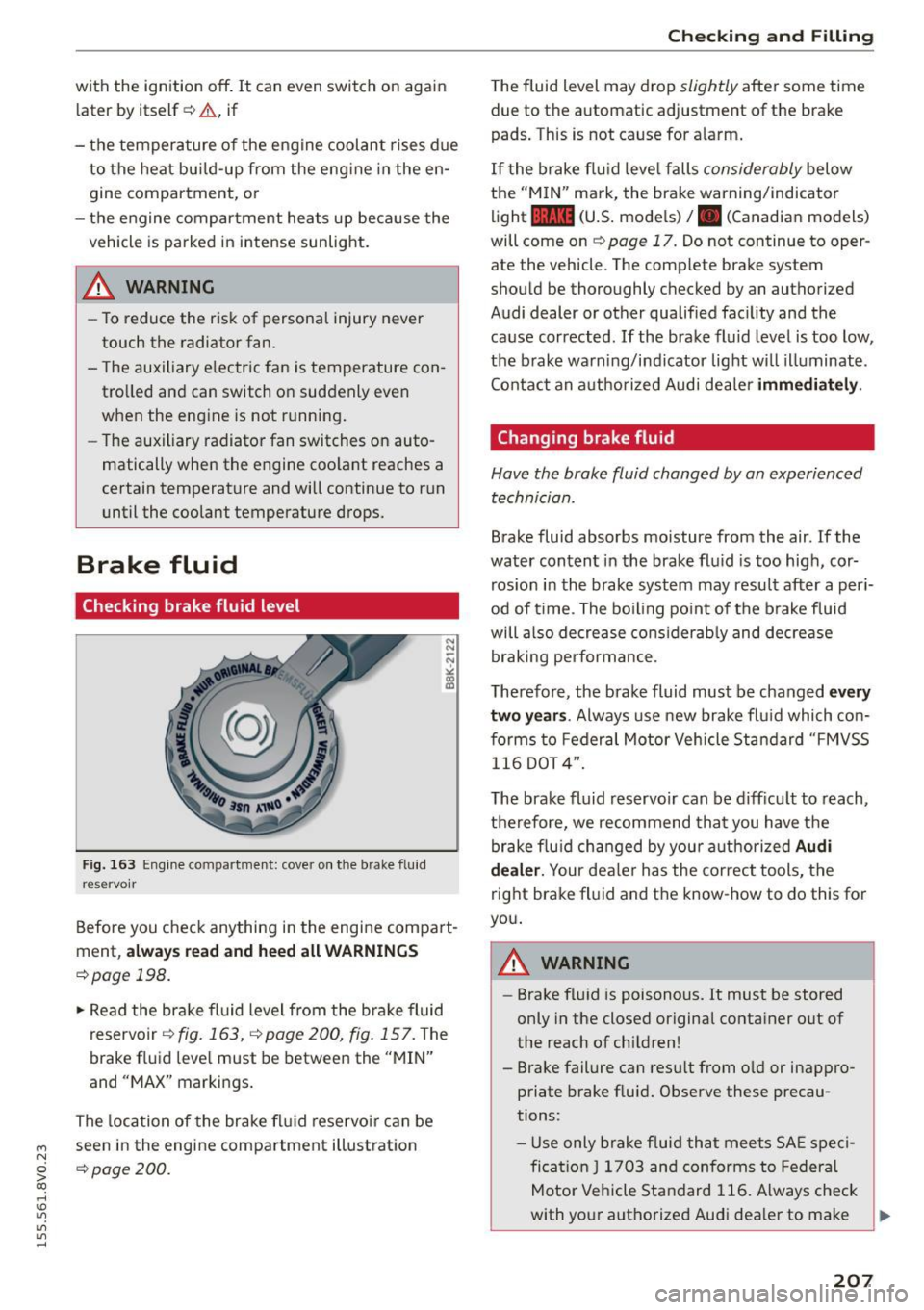
with the ignition off. It can even switch on again
l ater by itself~.& , if
- the temperature of the engine coolant rises due to the heat bui ld-up from the eng ine in the en
gine compartment, or
- the engine compar tment heats up because the
vehicle is parked in intense sunlight.
A WARNING , --
- To reduce the risk of personal injury never
touch the radiator fan.
- The auxiliary e lectric fan is temperature con
trolled and can switch on suddenly even
when the engine is not running.
- The aux iliary radiator fan switches on auto
matically when the engine coo lant reaches a
certain temperature and will continue to run
until the coolant temperature drops.
Brake fluid
Checking brake fluid level
Fig. 163 Engine compa rt m ent: cove r on the brake fluid
reservo ir
N N -N
"' :ll
Before you check anything i n the engine compa rt
ment,
al ways re ad and h eed all W ARN INGS
~page 198.
... Read the brake fluid level from the b ra ke fluid
reservoir
r¢ fig. 163, r:¢ page 200, fig. 157. The
brake f luid leve l must be between the "MIN"
and "MAX" markings.
The location of the brake fl uid reservo ir can be
...., seen in the engine compartment illustration
N
~ r¢ page 200.
co
rl I.O
"'
"'
"'
rl
Check in g and Fillin g
The fluid level may drop slightly after some time
due to the automatic adjustment of the brake
pads . This is not cause for a larm.
If the brake f luid leve l falls considerably below
the "MIN" mark, the brake warning/indicator
light
1111 (U.S. mode ls) I. (Canadian models)
will come on
~ page 17. Do not continue to oper
ate the vehicle . The comp lete brake system
should be thoroughly checked by an authorized
Audi dealer or other qualified fac ility and the
cause corrected . If the brake flu id level is too low,
the brake warning/indicator light wi ll illuminate .
Contact an a uthorized Audi dea ler
immedi ate ly .
Changing brake fluid
Have the brake fluid changed by an experienced
technician.
Brake fluid absorbs moisture from the air. If the
water content in the brake flu id is too hig h, cor
ros ion in the brake system may result after a per i
od of t ime. The bo iling po int of the brake fluid
will a lso decrease cons iderab ly and decrease
braking performance.
Therefore, the brake fluid must be changed
e ve ry
tw o years .
Always use new brake flu id which co n
forms to Federal Motor Vehicle Standard "FMVSS
116 DOT 4".
The brake fluid reservoir can be diff icu lt to reach,
therefore, we recommend tha t you have the
brake flu id changed by you r authorized
Audi
de aler.
Your dea le r has the correct tools, the
right brake fluid and the know-how to do this for
you .
A WARNING
- -
-Brake flu id is poisonous. It must be stored
only in the closed original conta iner out of
the reach of children !
- Brake failure can resu lt from o ld or inappro
priate brake fluid. Observe these precau
tions:
- Use only brake fluid that meets SA E spe ci
ficat ion
J 1703 and conforms to Federa l
Motor Vehicle Standard 116. Always check
with your a uthorized Audi dea ler to make
~
207
Page 269 of 282
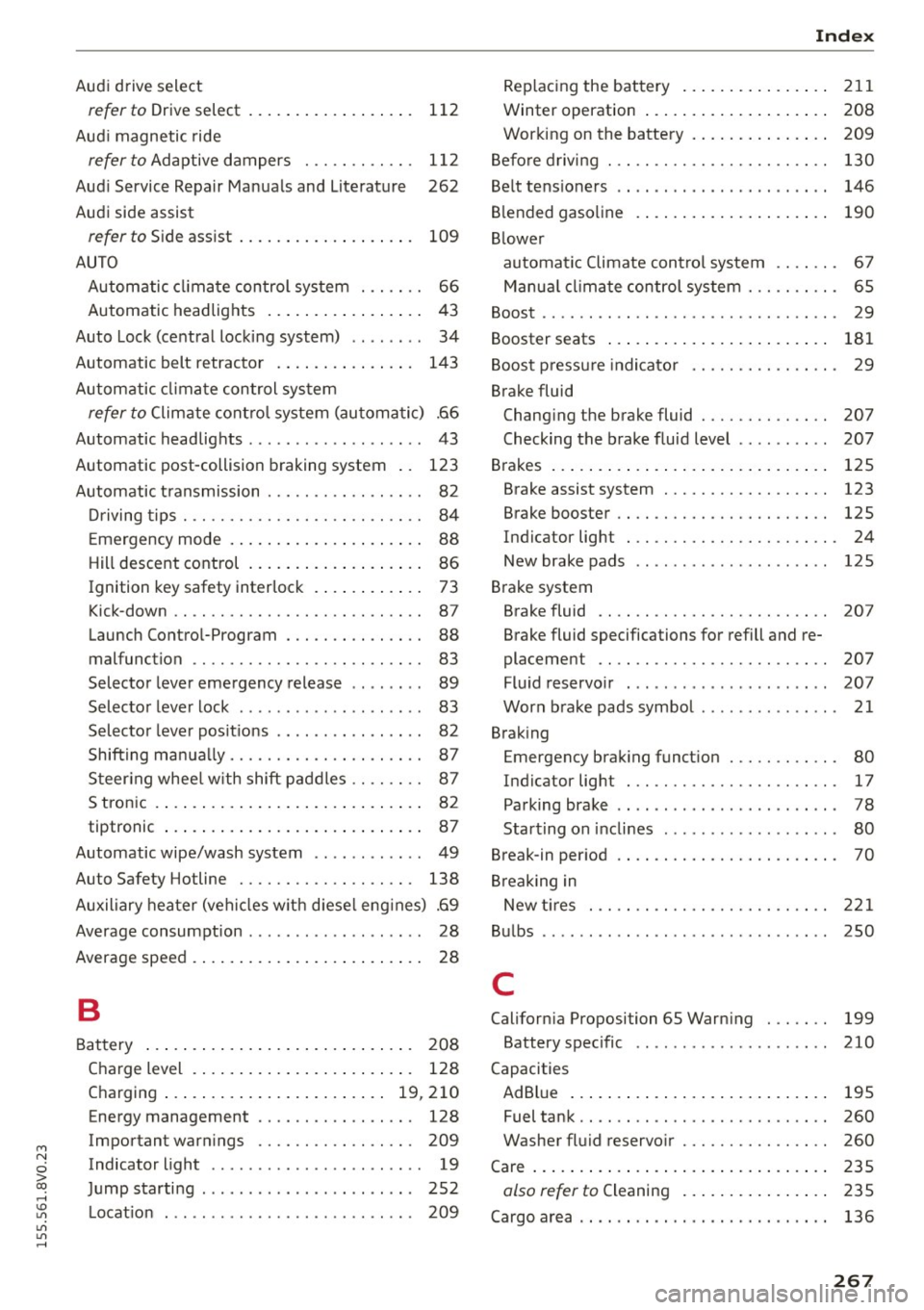
M N
0 > co ,...., \!) 1.1'1
1.1'1
1.1'1
,....,
Audi drive select
refer to Drive select . . . . . . . . . . . . . . . . . . 112
Aud i magnetic ride
refer to Adaptive dampers . . . . . . . . . . . . 112
Aud i Service Repair Manuals and Literature 262
Aud i side assist
refer to Side assist . . . . . . . . . . . . . . . . . . . 109
AUTO
Automatic climate control system . . . . . . . 66
Automatic headlights . . . . . . . . . . . . . . . . . 43
Auto Lock (central locking system) . . . . . . . . 34
Automatic belt retractor . . . . . . . . . . . . . . . 143
Automatic climate control system
refer to Climate control system (automatic) .66
Automatic headlights . . . . . . . . . . . . . . . . . . . 43
Automatic post-collision braking system . . 123
Automatic transmission . . . . . . . . . . . . . . . . . 82
Driving tips . . . . . . . . . . . . . . . . . . . . . . . . . . 84
Emergency mode . . . . . . . . . . . . . . . . . . . . . 88
Hill descent control . . . . . . . . . . . . . . . . . . . 86
Ignition key safety interlock . . . . . . . . . . . . 73
Kick-down . . . . . . . . . . . . . . . . . . . . . . . . . . . 8 7
Launch Control-Program . . . . . . . . . . . . . . . 88
malfunction . . . . . . . . . . . . . . . . . . . . . . . . .
83
Selector lever emergency release . . . . . . . . 89
Selector lever lock . . . . . . . . . . . . . . . . . . . . 83
Selector lever pos it ions . . . . . . . . . . . . . . . . 82
Shifting manually . . . . . . . . . . . . . . . . . . . . . 87
Steer ing whee l w ith shift paddles . . . . . . . . 87
S tronic . . . . . . . . . . . . . . . . . . . . . . . . . . . . . 82
tiptronic . . . . . . . . . . . . . . . . . . . . . . . . . . . . 87
Automatic wipe/wash system . . . . . . . . . . . . 49
Auto Safety Hotline . . . . . . . . . . . . . . . . . . . 138
Auxiliary heater (vehicles w ith diese l eng ines) .69
Average consumption . . . . . . . . . . . . . . . . . . . 28
Average speed . . . . . . . . . . . . . . . . . . . . . . . . . 28
B
Battery . . . . . . . . . . . . . . . . . . . . . . . . . . . . . 208
Charge level . . . . . . . . . . . . . . . . . . . . . . . . 128
Charging ... .. .............. ... .. 19,210
Energy management . . . . . . . . . . . . . . . . . 128
Important warnings . . . . . . . . . . . . . . . . . 209
Indicator light . . . . . . . . . . . . . . . . . . . . . . . 19
Jump starting . . . . . . . . . . . . . . . . . . . . . . . 252
L ocat ion . . . . . . . . . . . . . . . . . . . . . . . . . . . 209
Index
Replacing the battery . . . . . . . . . . . . . . . . 211
Winter operation . . . . . . . . . . . . . . . . . . . . 208
Working on the battery . . . . . . . . . . . . . . . 209
Before driving . . . . . . . . . . . . . . . . . . . . . . . . 130
Belt tens ioners . . . . . . . . . . . . . . . . . . . . . . . 146
B lended gasol ine . . . . . . . . . . . . . . . . . . . . . 190
B lower
automatic Climate control system . . . . . . . 67
Manual climate control system . . . . . . . . . . 65
Boost . . . . . . . . . . . . . . . . . . . . . . . . . . . . . . . . 29
Booster seats . . . . . . . . . . . . . . . . . . . . . . . . 181
Boost pressu re indicator . . . . . . . . . . . . . . . . 29
Brake fluid Changing the brake fluid . . . . . . . . . . . . . . 207
Checking the brake fluid level . . . . . . . . . . 207
Brakes . . . . . . . . . . . . . . . . . . . . . . . . . . . . . . 125
Brake assist system . . . . . . . . . . . . . . . . . . 123
Brake booster . . . . . . . . . . . . . . . . . . . . . . . 125
Indicator ligh t . . . . . . . . . . . . . . . . . . . . . . . 24
New brake pads . . . . . . . . . . . . . . . . . . . . . 125
Brake system Brake fluid . . . . . . . . . . . . . . . . . . . . . . . . . 20 7
Brake fluid specifications for refill and re
placement . . . . . . . . . . . . . . . . . . . . . . . . . 207
Fluid reservoir . . . . . . . . . . . . . . . . . . . . . . 207
Worn brake pads symbol . . . . . . . . . . . . . . . 21
Braking Emergency braking function . . . . . . . . . . . . 80
Indicator light . . . . . . . . . . . . . . . . . . . . . . . 17
Parking brake . . . . . . . . . . . . . . . . . . . . . . . . 78
Starting on inclines . . . . . . . . . . . . . . . . . . . 80
Break-in per iod . . . . . . . . . . . . . . . . . . . . . . . . 70
Breaking in New t ires ..... .. ............. .... .. 221
Bulbs . . . . . . . . . . . . . . . . . . . . . . . . . . . . . . . 250
C
California Proposition 65 Warning . . . . . . . 199
Battery specific . . . . . . . . . . . . . . . . . . . . . 210
Capacities AdBlue . . . . . . . . . . . . . . . . . . . . . . . . . . . . 195
Fuel tank. . . . . . . . . . . . . . . . . . . . . . . . . . . 260
Washer fluid reservoir . . . . . . . . . . . . . . . . 260
Care . . . . . . . . . . . . . . . . . . . . . . . . . . . . . . . . 235
olso refer to Cleaning . . . . . . . . . . . . . . . . 235
Cargo area . . . . . . . . . . . . . . . . . . . . . . . . . . . 136
267
Page 277 of 282
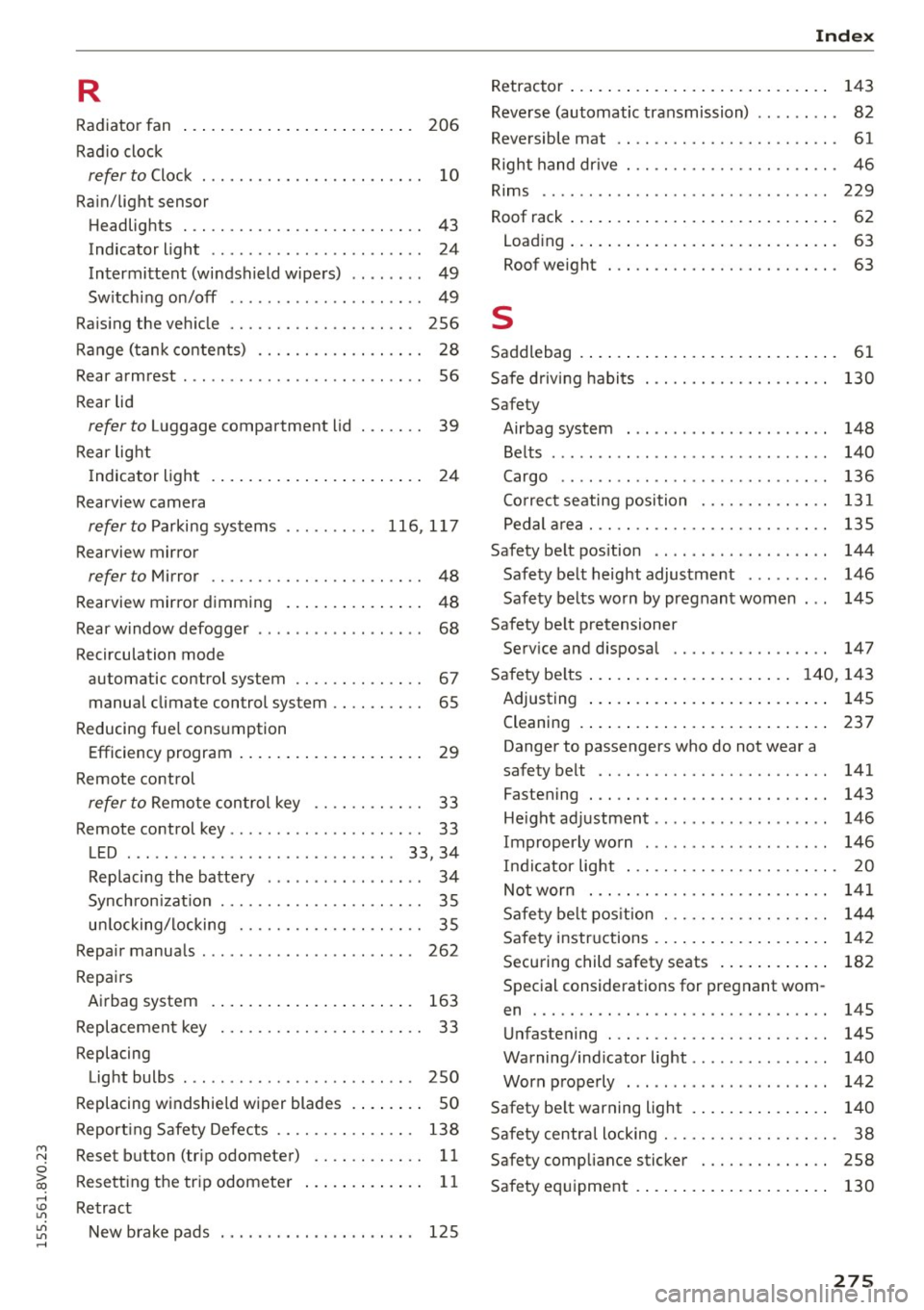
M N
0 > co ,...., \!) 1.1'1
1.1'1
1.1'1
,....,
R
Radiator fan
Radio clock 206
refer to Clock
. . . . . . . . . . . . . . . . . . . . . . . . 10
Rain/light sensor
Headlights . . . . . . . . . . . . . . . . . . . . . . . . . . 43
Indicator light . . . . . . . . . . . . . . . . . . . . . . . 24
Intermittent (windshield wipers) . . . . . . . . 49
Sw itching on/off . . . . . . . . . . . . . . . . . . . . . 49
Raising the vehicle . . . . . . . . . . . . . . . . . . . . 256
Range (tank contents) . . . . . . . . . . . . . . . . . . 28
Rear armrest . . . . . . . . . . . . . . . . . . . . . . . . . . 56
Rear lid
refer to luggage compartment lid . . . . . . . 39
Rear light
Indicator light . . . . . . . . . . . . . . . . . . . . . . . 24
Rearview camera
refer to Parking systems 116,117
Rearview mirror
refer to Mirror . . . . . . . . . . . . . . . . . . . . . . . 48
Rearview mirror dimming . . . . . . . . . . . . . . . 48
Rear window defogger . . . . . . . . . . . . . . . . . . 68
Recirculation mode
automatic control system . . . . . . . . . . . . . . 67
manual climate control system . . . . . . . . . . 65
Reducing fue l consumption
Efficiency program . . . . . . . . . . . . . . . . . . . . 29
Remote control
refer to Remote control key . . . . . . . . . . . . 33
Remote control key . . . . . . . . . . . . . . . . . . . . . 33
LED . . . . . . . . . . . . . . . . . . . . . . . . . . . . . 33, 34
Replacing the battery . . . . . . . . . . . . . . . . . 34
Synch ron izat ion . . . . . . . . . . . . . . . . . . . . . . 35
u nl ocking/locking . . . . . . . . . . . . . . . . . . . . 35
Repair manuals . . . . . . . . . . . . . . . . . . . . . . . 262
Repairs Airbag system . . . . . . . . . . . . . . . . . . . . . . 163
Replacement key . . . . . . . . . . . . . . . . . . . . . . 33
Replacing Light bulbs . . . . . . . . . . . . . . . . . . . . . . . . . 250
Replacing windshield wiper blades . . . . . . . . 50
Report ing Safety Defects . . . . . . . . . . . . . . . 138
Reset button (tr ip odometer) . . . . . . . . . . . . 11
Resetting the tr ip odometer . . . . . . . . . . . . . 11
Retract New brake pads . . . . . . . . . . . . . . . . . . . . . 125
Ind ex
Retractor . . . . . . . . . . . . . . . . . . . . . . . . . . . . 143
Reve rse (automatic transmission) . . . . . . . . . 82
Reversible mat . . . . . . . . . . . . . . . . . . . . . . . . 61
Right hand dr ive . . . . . . . . . . . . . . . . . . . . . . . 46
Rims ......... ... .. ................. 229
Roof rack . . . . . . . . . . . . . . . . . . . . . . . . . . . . . 62
Load ing . . . . . . . . . . . . . . . . . . . . . . . . . . . . . 63
Roof weight . . . . . . . . . . . . . . . . . . . . . . . . . 63
s
Saddlebag . . . . . . . . . . . . . . . . . . . . . . . . . . . . 61
Safe drivi ng habits . . . . . . . . . . . . . . . . . . . . 130
Safety Airbag system . . . . . . . . . . . . . . . . . . . . . . 148
Belts . . . . . . . . . . . . . . . . . . . . . . . . . . . . . . 140
Cargo . . . . . . . . . . . . . . . . . . . . . . . . . . . . . 136
Co rrect seating position . . . . . . . . . . . . . . 131
Pedal a rea . . . . . . . . . . . . . . . . . . . . . . . . . . 135
Safety be lt pos ition . . . . . . . . . . . . . . . . . . . 144
Safety belt height adjustment . . . . . . . . . 146
Safety be lts worn by pregnant women 145
Safety be lt pretensioner
Serv ice and disposal . . . . . . . . . . . . . . . . . 147
Safety be lts . . . . . . . . . . . . . . . . . . . . . . 1 40, 143
Adjusting . . . . . . . . . . . . . . . . . . . . . . . . . . 145
Cleaning . . . . . . . . . . . . . . . . . . . . . . . . . . . 23
7
Danger to passengers who do not wear a
safety belt . . . . . . . . . . . . . . . . . . . . . . . . . 141
Fastening . . . . . . . . . . . . . . . . . . . . . . . . . . 143
Height ad justment . . . . . . . . . . . . . . . . . . . 146
Improperly wo rn . . . . . . . . . . . . . . . . . . . . 146
Indicator lig ht . . . . . . . . . . . . . . . . . . . . . . . 20
Not worn . . . . . . . . . . . . . . . . . . . . . . . . . . 141
Sa fe ty be lt pos ition . . . . . . . . . . . . . . . . . . 144
Safety instr uctions . . . . . . . . . . . . . . . . . . . 142
Securing child safety seats . . . . . . . . . . . . 182
Special considerations for pregnant wom-
en . . . . . . . . . . . . . . . . . . . . . . . . . . . . . . . . 145
Unfastening . . . . . . . . . . . . . . . . . . . . . . . . 145
Warning/ind icator light . . . . . . . . . . . . . . . 140
Worn properly . . . . . . . . . . . . . . . . . . . . . . 142
Safety be lt warning light . . . . . . . . . . . . . . . 140
Safety centra l locking . . . . . . . . . . . . . . . . . . . 38
Safety compliance sticker . . . . . . . . . . . . . . 258
Safety eq uipment . . . . . . . . . . . . . . . . . . . . . 130
275